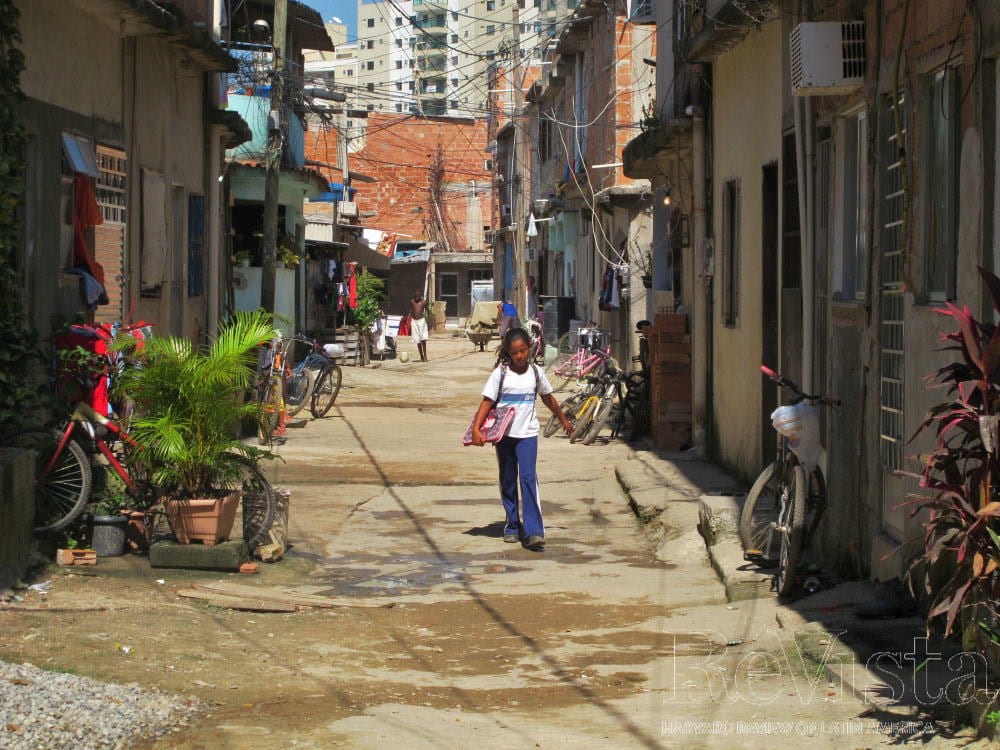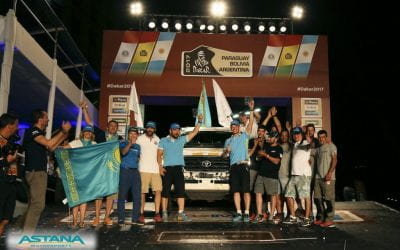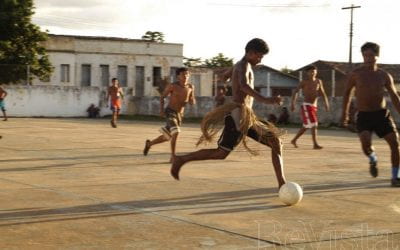This is a tale of two favelas: united in scarcity, divided by provision.
Favelas—“informal settlements” to the academic, “illegal slums” to the antipathetic—are spontaneous, grassroots communities found throughout Brazil. In Rio de Janeiro, host to the upcoming World Cup and Olympics events, these settlements are marbled throughout the wildly protruding landscape, clinging to hillsides and diving under viaducts. About one out of every five of Rio’s citizens calls a favela home. Much of what the outside world understands about Rio’s favelas is shaped by popular representations of savagery, criminality, and despair, such as the film Cidade de Deus (“City of God”). But in the peaceful spots, there is no organized crime or drug trade. People go to work, help their kids with homework, and enjoy a barbeque on the holidays. They exist outside the city’s networks of services, and not much ink is spilled about them. Now that the Olympics are coming to town, however, the world is beginning to take note.
Around the bend from the real Cidade de Deus—which is not technically a favela, but originally a social housing project built for favela evictees—are Asa Branca and Vila Autódromo. Separated by little more than half a mile, today these two favelacommunities have proximate geographies but divergent destinies. While the Summer Olympic Games are set to kick off in London later this year, the Rio 2016 Olympic juggernaut is already deciding winners and losers at home. So far, Asa Branca appears to be a winner, while Vila Autódromo’s fate hangs in limbo.
Both neighborhoods open up to the thoroughfare Avenida Salvador Allende, four lanes of traffic split by a broad, shrubby median, and a world apart from the rugged grandeur of the cidade maravilhosa. On this flat plain in Jacarepaguá—an indigenous name meaning “shallow alligator pond”—you are less likely see alligators than unfenced horses, their heads languidly bent to lap water from puddles along the avenue. In Chile, the name “Salvador Allende” brings to mind the Marxist president who led the nation down La vía chilena al socialismo—“the Chilean path to socialism.” But in Rio, Salvador Allende leads to the Barra mega-development cluster for the Olympic Games—that is to say, in quite the opposite direction of its ideological namesake.
The Avenida is, in many ways, a living spectacle of the unfolding clash between a mega-scale coalition of corporate and government elites and the micro-scale sensibilities of favela life. The self-built, self-contained Asa Branca is on the far northeast end, where most days Carlos Alberto “Bezerra” Costa can be found manning his hot dog stand in a row of local businesses facing the thoroughfare. As president of Asa Branca’s residents’ association, Bezerra is also the captain of a ship rocked by the first waves of the Olympics’ turbulent waters.
The city has informed community of its plans to condemn approximately thirty residences for demolition in order to make way for the TransOlímpica Bus Rapid Transit (BRT) line, which will transform the Avenida from a quiet surface road to one of Rio’s major transit corridors. In the face of this project, Bezerra is working to keep as many displaced residents within the community as possible. He is pragmatic in his dealings with the city: strategically combative when he thinks he can get concessions; cooperative when he is resigned to their position.
But while the introduction of a mass transit artery is set of shave off part of the village, new investments are also in the works. Because of its visibility to the Olympics Barra cluster, and therefore to international visitors, the community has been prioritized for urbanization through the Morar Carioca program. The latest incarnation of Rio’s favela upgrading efforts, Morar Carioca represents an R8 billion investment in city services and public space improvements for favelas, expressly favoring the communities within Olympics venue perimeters. Slated for Asa Branca are health clinics, land titling, and improvements to the sewerage system. So far, the community has had little input into the formulation of these projects, and Bezerra’s stance has had to be mainly reactive.
At face value, Morar Carioca will improve the quality of life in Asa Branca, but these improvements could be a mixed blessing. With urbanization and better services, the community becomes more conducive for formal development. With nearby sports venues and transportation infrastructure, it becomes attractive to middle-class households. And with land titling, it becomes commodified for property owners to sell on the open market. Together these ingredients constitute a recipe for gentrification, the displacement of lower-income households, and the breakdown of community cohesion and character. Tall condominium towers rising on land surrounding the community contribute to the sense of besiegement.
Despite their anxiety about rising real estate speculation and alterations to the urban fabric, Bezerra and his neighbors have made out reasonably well for the time being. But a short walk past the speeding cars and banana trees of Avenida Salvador Allende takes you to a village in far more precarious straits. Here, wedged in the interstitial space between the Avenida, a race track, and a large lagoon—the Lagoa de Jacarepaguá—is the fishing village of Vila Autódromo. Almost from the moment the International Olympic Committee announced that the 2016 Games would be awarded to Rio, this sleepy settlement has been embroiled in a battle with Rio’s city government over its future.
The Olympic Park, the focal point of the Barra Olympics cluster, is slated for this pie slice of land jutting out into the lagoon. While most of the site’s land area is taken up by the racetrack and is thus unpopulated, the city and the Brazilian Olympic Committee insist that the village (population 4,000) cannot remain as part of the redevelopment program, and they have begun the process of forced eviction. Vila Autódromo residents, who have endured this threat before and obtained right-to-use title in 1994, are fighting the action in court and in the hearts and minds of the international community.
One resident activist who has helped the community withstand pressures to relocate through the Rio Earth Summit in 1992, as well as the Pan-American Games in 2007, is 54-year-old Jane Nascimento de Oliveira. “The city government even went so far as to put a tractor by the entrance to the community to topple the houses,” she told community journalists last year. “So, the people closed the community and did not let anyone enter.” Today the community entrance has a welcome sign with a banner stretched beneath reading: Não remove meu sonho-Urbanize. “Don’t remove my dream–Urbanize.”
As it stands, the fate of Vila Autódromo is suspended over a gap that routinely opens up between policy and politics in Brazil. The intent of policy and law is clear: the community supposedly has secure tenure; squatters’ right to possession is granted after five years; and land takings are not legal except in certain circumstances, such as in areas of environmental risk. But despite this progressive policy environment, public officials often try to manipulate and intimidate their politically unsophisticated constituents, use divide-and-conquer tactics, or make transparently insincere claims such as the environmental risk gambit. Each of these justifications has been used at one time or another against Vila Autódromo.
Follow Avenida Salvador Allende further southwest to its end and you join up with a second planned BRT line, the TransOeste, which stretches across the Barra neighborhood on its way to Rio’s outer suburbs. In the wake of construction for this bit of infrastructure lie the remains of the demolished favelas of Restinga, Recreio II, and Vila Harmonia, the hollowed-out shells of the remaining structures a foreshadow of one possible future for Vila Autódromo. Here some of Rio’s most marginal residents, who may have lacked the political savvy of Bezerra or Jane, have been relocated to social housing projects even more remote from their long-time homes, jobs, and social networks. The legacy of Cidade de Deus lives on, in other words, and it and emanates in ever more remote reaches of the urban periphery.
Every four years, cities with Olympic glory in their hearts vie to host the Games. Then the debates rage, as inevitable as they are familiar. Are the Games a catalyst for investment and fame or a recipe for debt and corruption? Does the effort required expand access to jobs and public amenities or does it channel benefits mainly to the already wealthy and privileged? Indeed, the effect of the many exigencies and vast urban reshaping that comes with hosting the Games is complex and multi-faceted. But a place where the Olympics Games falls particularly short is in the area of spatial equity. From Seoul to Barcelona to Atlanta to Beijing, the Games have meant eviction, dispersal, worsened segregation, and diminished affordable housing in urban centers.
It doesn’t have to be this way. In the topsy-turvy logic of Rio’s Olympics planning, some communities are awarded long-needed improvements and services, while others get intimidation and deceit. The idea of social sustainability—that healthy societies depend on respect for community, civic participation, and organically formed connections to urban space—does not yet command the same purchase as sustainability in strictly economic or environmental terms. Tellingly, in the brief for the design for the Olympic Park, the section on ecological sustainability goes on for ten pages, while a short paragraph regarding “social inclusion” remains unheeded. Today Asa Branca comes out ahead, but tomorrow the urban growth machine could reverse course and decide that it, too, needs to go. Such is the predicament of what favela scholar Janice Perlman calls “living on the edge”.





